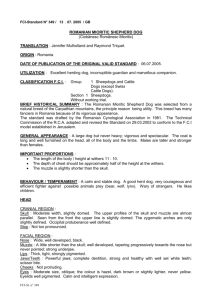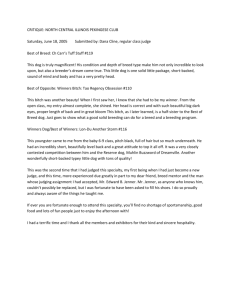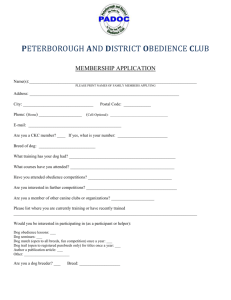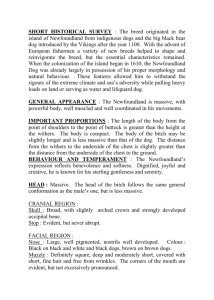Neck, Topline, Body - White River Shorthairs
advertisement
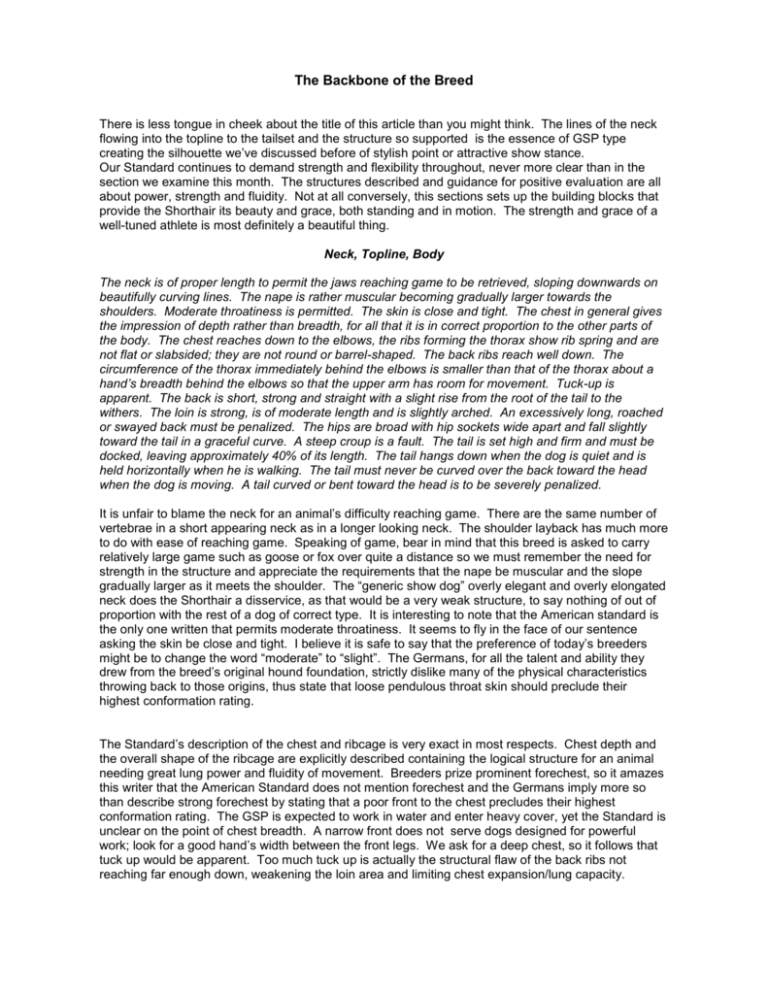
The Backbone of the Breed There is less tongue in cheek about the title of this article than you might think. The lines of the neck flowing into the topline to the tailset and the structure so supported is the essence of GSP type creating the silhouette we’ve discussed before of stylish point or attractive show stance. Our Standard continues to demand strength and flexibility throughout, never more clear than in the section we examine this month. The structures described and guidance for positive evaluation are all about power, strength and fluidity. Not at all conversely, this sections sets up the building blocks that provide the Shorthair its beauty and grace, both standing and in motion. The strength and grace of a well-tuned athlete is most definitely a beautiful thing. Neck, Topline, Body The neck is of proper length to permit the jaws reaching game to be retrieved, sloping downwards on beautifully curving lines. The nape is rather muscular becoming gradually larger towards the shoulders. Moderate throatiness is permitted. The skin is close and tight. The chest in general gives the impression of depth rather than breadth, for all that it is in correct proportion to the other parts of the body. The chest reaches down to the elbows, the ribs forming the thorax show rib spring and are not flat or slabsided; they are not round or barrel-shaped. The back ribs reach well down. The circumference of the thorax immediately behind the elbows is smaller than that of the thorax about a hand’s breadth behind the elbows so that the upper arm has room for movement. Tuck-up is apparent. The back is short, strong and straight with a slight rise from the root of the tail to the withers. The loin is strong, is of moderate length and is slightly arched. An excessively long, roached or swayed back must be penalized. The hips are broad with hip sockets wide apart and fall slightly toward the tail in a graceful curve. A steep croup is a fault. The tail is set high and firm and must be docked, leaving approximately 40% of its length. The tail hangs down when the dog is quiet and is held horizontally when he is walking. The tail must never be curved over the back toward the head when the dog is moving. A tail curved or bent toward the head is to be severely penalized. It is unfair to blame the neck for an animal’s difficulty reaching game. There are the same number of vertebrae in a short appearing neck as in a longer looking neck. The shoulder layback has much more to do with ease of reaching game. Speaking of game, bear in mind that this breed is asked to carry relatively large game such as goose or fox over quite a distance so we must remember the need for strength in the structure and appreciate the requirements that the nape be muscular and the slope gradually larger as it meets the shoulder. The “generic show dog” overly elegant and overly elongated neck does the Shorthair a disservice, as that would be a very weak structure, to say nothing of out of proportion with the rest of a dog of correct type. It is interesting to note that the American standard is the only one written that permits moderate throatiness. It seems to fly in the face of our sentence asking the skin be close and tight. I believe it is safe to say that the preference of today’s breeders might be to change the word “moderate” to “slight”. The Germans, for all the talent and ability they drew from the breed’s original hound foundation, strictly dislike many of the physical characteristics throwing back to those origins, thus state that loose pendulous throat skin should preclude their highest conformation rating. The Standard’s description of the chest and ribcage is very exact in most respects. Chest depth and the overall shape of the ribcage are explicitly described containing the logical structure for an animal needing great lung power and fluidity of movement. Breeders prize prominent forechest, so it amazes this writer that the American Standard does not mention forechest and the Germans imply more so than describe strong forechest by stating that a poor front to the chest precludes their highest conformation rating. The GSP is expected to work in water and enter heavy cover, yet the Standard is unclear on the point of chest breadth. A narrow front does not serve dogs designed for powerful work; look for a good hand’s width between the front legs. We ask for a deep chest, so it follows that tuck up would be apparent. Too much tuck up is actually the structural flaw of the back ribs not reaching far enough down, weakening the loin area and limiting chest expansion/lung capacity. A major key to producing GSP breed type is the topline portion of our silhouette. Our written guide is a little confusing in that it asks for a straight, short, strong back with gradual rise from tail to withers. Yet, so much to do with endurance comes from the next sentence requiring a moderate and slightly arched loin. Many a breed student has scratched their head trying to reconcile these two statements. It can be done looking at a good typey Shorthair. The back has a point where the spine subtly changes direction, coincident with the change from supporting the hanging ribs (thoracic vertebrae) to the slight arch of the loin (lumbar vertebrae). The ideal dog does not let this show in the topline by carrying excellent long smooth muscle. We don’t want to get too carried away with the word moderate when allowing length of loin. A longer ribcage and shorter loin is definitely preferred resulting in the overall short-backed look. The problem of the longer and therefore weaker back is generally that of the loin area being too long. A slight arch is desirable in the loin, exuding strength and power. Carried too far in a loin too long gives an unattractive roach to the back. We say we permit more length in a bitch due to breeding necessities, but for her sake and that of the litters she may carry, let her length be more in the ribcage than the loin. She’ll just have to keep you guessing as to how many whelps she may have tucked into that stronger structure. Now we come to the finale of this appealing and sturdy build; broad hip sockets working to a slight curve toward the base of the tail. High and firm referring to the tail set does not mean stuck on at the peak of the pelvis. There is some important muscle over the croup area which if shortened, threatens agility. High tail set might enhance the “generic show dog” look, but watching such a dog in motion should prove its weakness. Other side of the coin; an overly steep croup is unattractive and produces the lower tail set which eventually will limit the dog’s drive off the rear. Another common “generic show dog” and also “stylish point” misconception concerns tail carriage. The Standard written for this most businesslike dog asks for level carriage in motion, and downward when quiet. The handling trick of tweaking the tail up past 45 degrees, thus shortening the appearance of the back has become the norm. Wise would be the evaluator who required the dog be allowed to hold the tail naturally, getting a true picture of the topline. The Standard penalizes tails curved or bent toward the head. This may be yet more evidence of the German tendency to ferret out characteristics that are too “houndy”. Just as long as we don’t get rid of the tracking capabilities or intense game drive, heh? One word about tail docking. The Germans began docking tails for both practical and cosmetic reasons. Just as the show horse’s tail is bundled up to enhance appearance, so the docked tail lends a stronger look to the rear. Practically speaking, the somewhat heavy and curved tails inherited from the hound ancestry were terribly susceptible to injury – with the constant wagging of this happy companion creating conditions contrary to fast and clean healing. The European dock tends to be longer than the American, closer to half remaining than the 40 percent specified in the US Standard. It is generally held that too long is better than too short for appearance’s sake – but its length of tail is not the dog’s or its sire or dam’s fault, and should be disregarded when evaluating conformation. So, we have added flesh and bone, function and structure to our breed silhouette. Coupled with the headpiece, we have gone a long way in the attempt to put into words our breed type. Ponder the anatomy described in this Standard section and the reasons behind the physical requirements. “ If you were to see his outline on a wall you would know that he was a Shorthair and not confuse him with any other breed” Contributors: Heather Brennan, Nuthatch Sharon Dattilio, Shomberg Kim Endicott, Endeavor Char Rutar, White River G. Byrne, Der Deutsch-Kurzhaar, 1989 C. B. Maxwell, The New German Shorthaired Pointer, 1965
